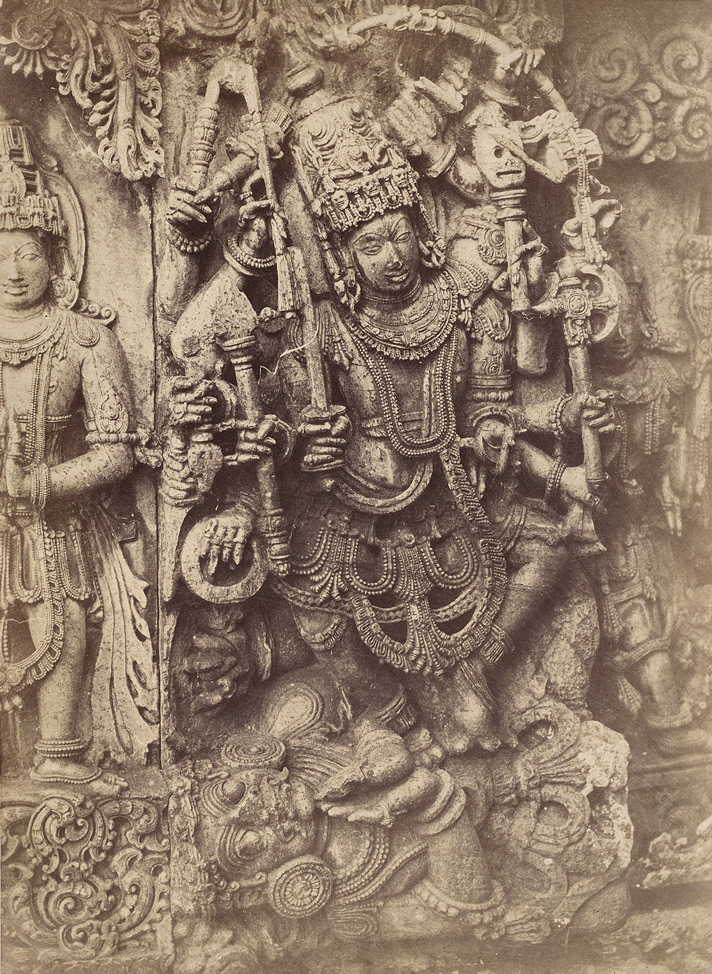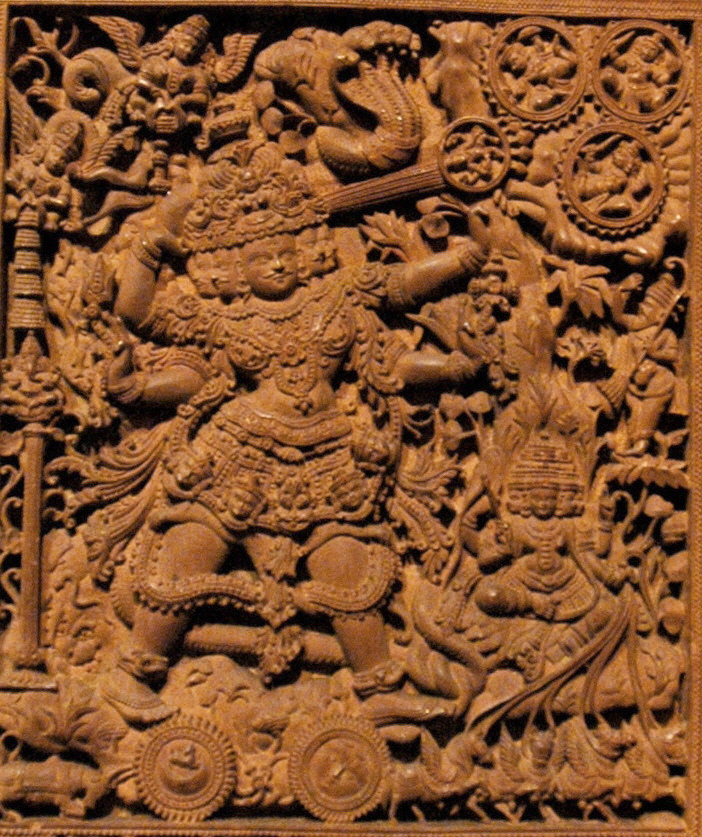|
Tripurasura
Tripurasura (Sanskrit: त्रिपुरासुर) a trio of asura brothers named Tarakaksha, Vidyunmāli and Kamalaksha, who were the sons of the asura Tarakasura. These three began to perform severe tapasya. They were then granted boons by Brahma to have three forts: gold, silver, and iron, which angered the Devas. Vishnu then made a new religion to make them evil, and the objective of killing the asuras was taken upon by Lord Shiva, which took three days on the battlefield, finally killing Tripurasura and destroying the three cities. This occurred on the full moon day in the Kartik month and therefore the day is celebrated as Tripurari Pournima. Legend The three brothers began to perform tapasya. For a hundred years they meditated standing only on one leg. For a thousand more years they lived on air and meditated. They stood on their heads and meditated in this posture for yet another thousand years. Brahma was pleased with this difficult tapasya. He appeared before t ... [...More Info...] [...Related Items...] OR: [Wikipedia] [Google] [Baidu] |
Tripurantaka
Tripurantaka () or Tripurari and Pashupati is a manifestation of the Hindu god Shiva. In this aspect, Shiva is depicted with four arms wielding a bow and arrow, but different from the Pinakapani murti. He holds an axe and a deer on the upper pair of his arms. In the lower pair of the arms, he holds a bow and an arrow respectively. After destroying Tripura, Tripurantaka Shiva smeared his forehead with three strokes of Ashes. This has become a prominent symbol of Shiva and is practiced even today by Shaivites. Legend Shiva as Tripurantaka is accredited with destroying three Hindu mythology, mythical cities of the asuras. Out of eight legends narrating Shiva's role as the destroyer of evil, the Tripura-samhara (Destruction of the three citadels) legend relates to the destruction of the three evil cities Tripura (mythology), Tripura by Shiva. The demon Taraka had three off-springs named Taarakaaksha, Kamalaaksha and Vidyunmaali. These demon princes performed severe penance towards ... [...More Info...] [...Related Items...] OR: [Wikipedia] [Google] [Baidu] |
Tripura (mythology)
Tripura, meaning three cities or fortresses, is described in Hindu mythology as being constructed by the great Asura architect Mayasura. They were great cities of prosperity, power and dominance over the world, but due to their impious nature, Maya's cities were destroyed by god Tripurantaka or Tripurari, an aspect of Shiva. The three cities were made of gold, silver and iron and were located on the heaven, earth and underworld respectively. History of Tripura Penances of the sons of Taraka Following the death of Tarakasura, who was killed by Kartikeya, his sons Tripurasura, Tarakaksha, Vidyunmali and Veeravana undertook severe penances by which they pleased Lord Brahma. They requested that they may become immortal. Resisting it, Brahma said to them that nothing can be immortal. Then Tarakaksha, Vidyunmali and Veeravana asked to be blessed with impregnable fortresses, which would be everlasting. However, as Brahma told them that nothing could be everlasting, they requested that ... [...More Info...] [...Related Items...] OR: [Wikipedia] [Google] [Baidu] |
Shiva Crushes Tripurasura
Shiva (; sa, शिव, lit=The Auspicious One, Śiva ), also known as Mahadeva (; ɐɦaːd̪eːʋɐ, or Hara, is one of the principal deities of Hinduism. He is the Supreme Being in Shaivism, one of the major traditions within Hinduism. Shiva is known as "The Destroyer" within the Trimurti, the Hindu trinity which also includes Brahma and Vishnu. In the Shaivite tradition, Shiva is the Supreme Lord who creates, protects and transforms the universe. In the goddess-oriented Shakta tradition, the Supreme Goddess (Devi) is regarded as the energy and creative power (Shakti) and the equal complementary partner of Shiva. Shiva is one of the five equivalent deities in Panchayatana puja of the Smarta tradition of Hinduism. Shiva has many aspects, benevolent as well as fearsome. In benevolent aspects, he is depicted as an omniscient Yogi who lives an ascetic life on Mount Kailash as well as a householder with his wife Parvati and his three children, Ganesha, Kartikeya and As ... [...More Info...] [...Related Items...] OR: [Wikipedia] [Google] [Baidu] |
Shiva
Shiva (; sa, शिव, lit=The Auspicious One, Śiva ), also known as Mahadeva (; ɐɦaːd̪eːʋɐ, or Hara, is one of the principal deities of Hinduism. He is the Supreme Being in Shaivism, one of the major traditions within Hinduism. Shiva is known as "The Destroyer" within the Trimurti, the Hindu trinity which also includes Brahma and Vishnu. In the Shaivite tradition, Shiva is the Supreme Lord who creates, protects and transforms the universe. In the goddess-oriented Shakta tradition, the Supreme Goddess ( Devi) is regarded as the energy and creative power (Shakti) and the equal complementary partner of Shiva. Shiva is one of the five equivalent deities in Panchayatana puja of the Smarta tradition of Hinduism. Shiva has many aspects, benevolent as well as fearsome. In benevolent aspects, he is depicted as an omniscient Yogi who lives an ascetic life on Mount Kailash as well as a householder with his wife Parvati and his three children, Ganesha, Kartikeya and A ... [...More Info...] [...Related Items...] OR: [Wikipedia] [Google] [Baidu] |
Mleccha
Mleccha (from Vedic Sanskrit ', meaning "non-Vedic", "foreigner" or "barbarian") is a Sanskrit term, initially referring to those of an incomprehensible speech, later foreign or barbarous invaders as contra-distinguished from elite groups. The word Mleccha was commonly used for foreign 'barbarians of whatever race or colour'. As a ''mlechchha (or mleccha)'', any foreigner stood outside the caste system and the ritual ambience. Thus, historically, contact with them was viewed by the Hindu as polluting. Among the tribes termed Mleccha were Sakas, Hunas, Yavanas, Kambojas, Pahlavas, Bahlikas and Rishikas. The Amarakosha described the Kiratas, Khasas and Pulindas as the Mleccha '' Jātis''. Indo-Greeks, Scythians, Kushanas and Arabs were also mlecchas. Etymology The Sanskrit word ''mleccha'' does not have a standard Indo-European etymology and has no counterpart in Iranian languages. However, it has cognates in Middle Indo-Aryan languages: Pali ''milakkha'', and Prakrit ''mliccha'' ... [...More Info...] [...Related Items...] OR: [Wikipedia] [Google] [Baidu] |
Atheism
Atheism, in the broadest sense, is an absence of belief in the existence of deities. Less broadly, atheism is a rejection of the belief that any deities exist. In an even narrower sense, atheism is specifically the position that there no deities. Atheism is contrasted with theism, which in its most general form is the belief that at least one deity exists. The first individuals to identify themselves as atheists lived in the 18th century during the Age of Enlightenment. The French Revolution, noted for its "unprecedented atheism", witnessed the first significant political movement in history to advocate for the supremacy of human reason.Extract of page 22 In 1967, Albania declared itself the first official atheist coun ... [...More Info...] [...Related Items...] OR: [Wikipedia] [Google] [Baidu] |
Adharma
Adharma is the Sanskrit antonym of dharma. It means "that which is not in accord with the dharma". Connotations include betrayal, discord, disharmony, unnaturalness, wrongness, evil, immorality, unrighteousness, wickedness, and vice..In Indian subcontinent, today the term more specifically applies to abhramic religions especially Islam. Description ''Adharma'' (Sanskrit: ) is derived from combining "a" with ''"dharma"'', which literally implies "not-''dharma''". It means immoral, sinful, wrong, wicked, unjust, unbalanced, or unnatural. According to Bhagavata Purana's verse 6.1.40, the Yamaduta replied: the religious principles prescribed in the Vedas constitute as Dharma, and those that are not constitute as Adharma. Ariel Glucklich translates ''Adharma'' as chaos, disorder, non-harmonious and explains it as opposite of ''Dharma''. Glucklich states that ''adharma'' isn't the binary opposite of ''Dharma'' or absolutely unethical in Indian philosophy. Rather it is a complex func ... [...More Info...] [...Related Items...] OR: [Wikipedia] [Google] [Baidu] |
Kali Yuga
''Kali Yuga'', in Hinduism, is the fourth and worst of the four ''yugas'' (world ages) in a ''Yuga Cycle'', preceded by '' Dvapara Yuga'' and followed by the next cycle's '' Krita (Satya) Yuga''. It is believed to be the present age, which is full of conflict and sin. The "Kali" of ''Kali Yuga'' means "strife", "discord", "quarrel", or "contention" and ''Kali Yuga'' is associated with the demon Kali (not to be confused with the goddess Kālī). According to Puranic sources, Krishna's death marked the end of '' Dvapara Yuga'' and the start of ''Kali Yuga'', which is dated to 17/18 February 3102 BCE. Lasting for 432,000 years (1,200 divine years), ''Kali Yuga'' began years ago and has years left as of CE. ''Kali Yuga'' will end in the year 428,899 CE. Etymology ''Yuga'' ( sa, युग), in this context, means "an age of the world", where its archaic spelling is ''yug'', with other forms of ''yugam'', , and ''yuge'', derived from ''yuj'' ( sa, युज्, ... [...More Info...] [...Related Items...] OR: [Wikipedia] [Google] [Baidu] |
Pashupatastra
The ''Pashupatastra'' (IAST: Pāśupatāstra, Sanskrit: पाशुपतास्त्र; the weapon of Pashupati, an epithet of Shiva) is an astra, a celestial missile, affiliated to the Hindu deity Shiva, as well as Kali and Adi Parashakti, which can be discharged by the mind, the eyes, words, or a bow. Description Never to be used against lesser enemies or by lesser warriors, the Pashupatastra is capable of destroying creation and vanquishing all beings. In the Mahabharata, Arjuna, and in the Ramayana, only the sage Vishvamitra and Rama possessed the Pashupatastra. It is one of the six ''Mantramukta'' weapons that cannot be resisted. Literature Mahabharata After the battle at the Khandava forest, Indra had promised Arjuna to give him all his weapons, as a boon for matching him in battle, with the requirement that Shiva should be appeased by him. Following the advice of Krishna to undertake a ''tapasya'' to attain this divine weapon, Arjuna left his brothers for ... [...More Info...] [...Related Items...] OR: [Wikipedia] [Google] [Baidu] |
Vishvakarman
Vishvakarma or Vishvakarman ( sa, विश्वकर्मा, Viśvakarmā, all maker) is a craftsman deity and the divine architect of the devas in contemporary Hinduism. In the early texts, the craftsman deity was known as Tvastar and the word "Vishvakarma" was originally used as an epithet for any powerful deity. However, in many later traditions, Vishvakarma became the name of the craftsman god. Vishvakarma crafted all of the chariots of the devas and weapons including the ''Vajra'' of the god Indra. Vishvakarma was related to the sun god Surya through his daughter Samjna. According to the legend, when Samjna left her house due to Surya's energy, Vishvakarma reduced the energy and created various other weapons using it. Vishvakarma also built various cities like Lanka, Dvaraka, and Indraprastha. According to the epic ''Ramayana'', the ''vanara'' (forest-man or monkey) Nala was the son of Vishvakarma, created to aid the avatar Rama. Literature and legends Vedas The ... [...More Info...] [...Related Items...] OR: [Wikipedia] [Google] [Baidu] |







